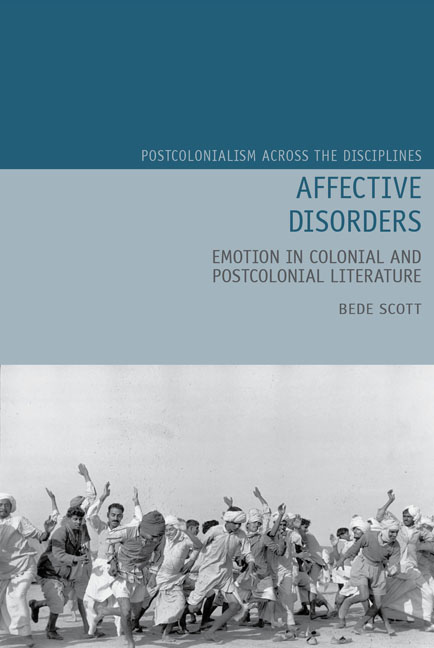Book contents
- Frontmatter
- Dedication
- Contents
- Acknowledgements
- Introduction
- 1 Anger: Naguib Mahfouz's Midaq Alley
- 2 Reticence: Vikram Seth's A Suitable Boy
- 3 Jealousy: Joaquim Maria Machado de Assis’ Dom Casmurro
- 4 Boredom: Upamanyu Chatterjee's English, August: An Indian Story
- 5 Fear: Michael Ondaatje's Anil's Ghost
- 6 Stuplimity: Vikram Chandra's Sacred Games
- Works Cited
- Index
Introduction
- Frontmatter
- Dedication
- Contents
- Acknowledgements
- Introduction
- 1 Anger: Naguib Mahfouz's Midaq Alley
- 2 Reticence: Vikram Seth's A Suitable Boy
- 3 Jealousy: Joaquim Maria Machado de Assis’ Dom Casmurro
- 4 Boredom: Upamanyu Chatterjee's English, August: An Indian Story
- 5 Fear: Michael Ondaatje's Anil's Ghost
- 6 Stuplimity: Vikram Chandra's Sacred Games
- Works Cited
- Index
Summary
[T]he affective quality of the world matters more than its geography.
Mikel Dufrenne, The Phenomenology of Aesthetic Experience, 1953[Feeling] is nothing without form.
Gustave Flaubert, Letter to Louise Colet, 12 August 1846I would like to begin, if I may, in a rather unpredictable place: provincial France in the summer of 1789. At this time, the country was undergoing a political and economic crisis that has been well-documented. The harvest had failed, food prices were rising, and unemployment was rife. In Paris, the Revolution was gathering momentum, and as news of the fall of the Bastille filtered through to the provinces, a number of rumours began to circulate. It was said that the aristocracy were planning to subdue the uprising by force, and that they had recruited foreign soldiers and ‘brigands’ in order to do so. It was also said that this army of mercenaries would be marching through the provinces to quell the various disturbances that had taken place there too. These rumours travelled with astonishing speed, and as they moved from village to village, they produced a particular kind of affective response that has come to be known as the Great Fear of 1789. People everywhere experienced an overwhelming sense of panic and anxiety, but this was not a vague and intangible national mood; it was a circulation of feeling whose speed and specific coordinates, at any given point in time, can be traced with remarkable accuracy (see Figure 1). According to Georges Lefebvre, the fear travelled from Clermont-en-Beauvaisis to the Seine, a distance of about fifty kilometres, in twelve hours. As it moved more slowly at night, it covered the five hundred kilometres from Ruffec to Lourdes in nine days, while elsewhere it travelled ‘from Livron to Arles – a hundred and fifty kilometres – in forty hours, which makes [an average of] four kilometres an hour, night and day’ (Lefebvre, Great 155). In his classic study of the Revolution, Lefebvre was able to follow the progress of this emotion as it was transmitted throughout the provinces:
A ‘disturbance’ at Nantes alarmed Poitou. At Estrées-Saint-Denis, in the Beauvais, another spread fright in all directions. A third in southern Champagne sowed terror through the Gâtinais, Bourbonnais, and Burgundy.
- Type
- Chapter
- Information
- Affective DisordersEmotion in Colonial and Postcolonial Literature, pp. 1 - 30Publisher: Liverpool University PressPrint publication year: 2019



